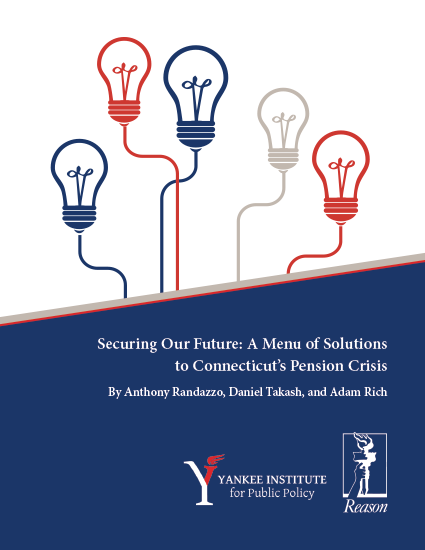Securing Our Future: A Menu of Solutions to Connecticut’s Pension Crisis
By Anthony Randazzo, Daniel Takash, and Adam Rich
Reform Puts People Before Pensions
Lawmakers can change the future of Connecticut by putting people before pensions. Right now, people in our state suffer because we put pensions first.
- Families suffer when loved ones don’t receive care. Those cuts happen, in large part, because we budget for pensions before people and then decide how many services we can afford.
- Younger state workers lose their jobs because the unions that supposedly represent them put pensions before people.
- Commuters lose time with their families in unnecessary and potentially hazardous traffic because we put pensions before people – spending $2 on pensions for every $1 we spend on transportation.
To address this vexing problem, the Yankee Institute commissioned Securing Our Future: A Menu of Solutions to Connecticut’s Pension Crisis. Backed by a full actuarial model of the State Employee Retirement System, this report outlines options for putting people before pensions and getting Connecticut out of a repeated cycle of deficits.
The report was written by Anthony Randazzo and Daniel Takash from the Reason Foundation’s Pension Integrity Project and Adam Rich, a Fellow of the Casualty Actuarial Society and resident of South Windsor.
Pension reform will have an immediate impact on the people of Connecticut. Over the next two years, Connecticut faces deficits of more than $3 billion. Pension reform could save hundreds of millions of dollars over the next two years. It could mean the difference between services continuing rather than being cut, and alleviate the need for yet more tax increases that will hurt homeowners across the state.
If even a few of the reforms in this paper were enacted, the state could save hundreds of millions of dollars a year in payments to our pension system, and almost $9 billion over the next 30 years. One reform alone – bringing employee contributions up to the national average level of 6 percent – would save $290 million over the next two years.
“For too long, Connecticut has put pensions before people. It is time we rethought our priorities so that people come first,” said Carol Platt Liebau, president of the Yankee Institute. “We can prevent a great deal of suffering across our state if we put people before pensions.”
“We have to decide whether retirement benefits for future state workers are more important than people who are actually suffering today,” Liebau said.
“Lawmakers recently refinanced Connecticut’s pension payments. It’s a bit like refinancing the mortgage on a house you can’t afford,” said Suzanne Bates, policy director for the Yankee Institute. “Not a bad first step, but you still need to sell the house.”
The potential solutions in the paper include changes to the governance of SERS; changes to existing benefits that would require approval from state employee unions; and changes to benefits for future workers which could be set in statute by lawmakers.
The proposed reforms will help Connecticut meet a range of goals.
- Fair. Right now, non-government workers in Connecticut pay extra taxes to support state worker pensions of which they could only dream. This unfair system hurts people at all income levels simply because they don’t work for government.
- Affordable. Since 2001, pension costs have grown faster than government spending or tax revenue, meaning that other spending priorities have received less funding. Unaffordable pensions mean less care for the disabled, worse road conditions and higher taxes. Unfunded pension promises loom over families and employers as future tax increases when they make decisions about where to live and locate.
- Stable and transparent. Connecticut has an obligation to keep its retirement promises to current and retired state employees. Modifying future promises is one way to increase the likelihood that existing promises are kept. The recent SEBAC agreement refinanced pension costs to avoid large planned spikes in the future. The agreement did not address unplanned uncertainty. Current projections assume pension fund investments will earn 6.9 percent every year. If returns fall a little short and reach an average of 6 percent (which is higher than recent returns), pension costs in 2040 will go up by 30 percent.
The current pension system is not transparent. It is impossible to know how much it will cost to pay a state employee’s pension until that employee – or his or her spouse – die, long after he or she stopped working. This lack of clarity makes it difficult to budget. Under the current system, decisions made today will ripple through state finances for decades.
Connecticut pensions appear similar in overall cost compared to other state systems, but two things make them different. Typically, these comparisons are done relative to payroll. Connecticut state employees tend to earn more than employees of other states, which makes a pension worth the same percent of pay even more valuable. (For example, the average state employee salary here is $10,000 higher than the average salary in Massachusetts, and $5,000 higher than the average in New York.) The second issue is that although the cost as a percentage of payroll is similar to other states, the costs are shared very differently in Connecticut. The most a non-hazardous state employee contributes is 2 percent of payroll. The national average is 6 percent.
Securing Our Future builds on past Yankee Institute projects including Born Broke (2014) on the enormity of Connecticut’s unfunded pension promises and Unequal Pay (2015), which showed Connecticut state employees earn at least 25 percent more than non-government workers with the same skills and experience.

